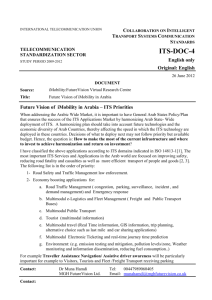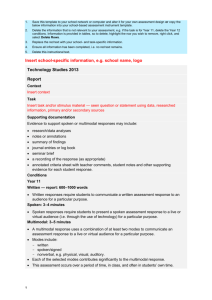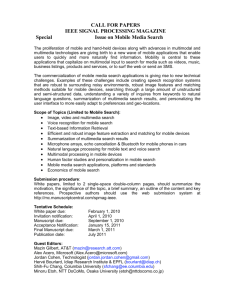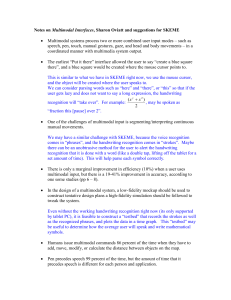Smith_Renner_IRA2 - TILE-sig
advertisement
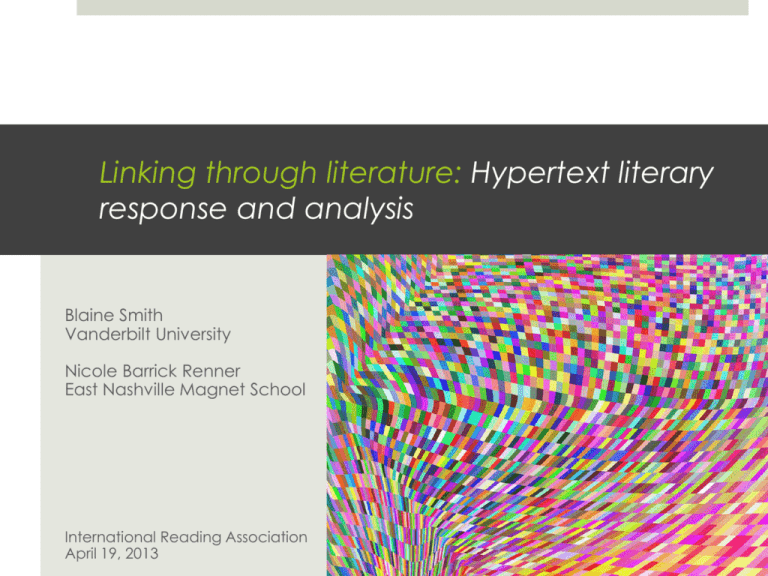
Linking through literature: Hypertext literary response and analysis Blaine Smith Vanderbilt University Nicole Barrick Renner East Nashville Magnet School International Reading Association April 19, 2013 OverviewIntroduction of Presentation The Things They Carried unit & multimodal projects Connections to Common Core standards Scaffolding & multimodal workshops Examples of student products Findings: Teacher & researcher perspectives Lessons we learned What is Multimodal Composition? Definition: A digital product with two or more modes What are modes? print speech sound visuals (images, artwork, photography, maps, etc.) movement (animation, dance, gesture, etc.) color Why is Multimodal Composition Important? Shifts in compositional practices: “producing a revolution in the uses and effects of literacy and of associated means for representing and communicating at every level and in every domain” (Kress, 2003, p. 1) 64% of teens12-17 create and share multimodal content online (Lenhart, Madden, Macgill, & Smith, 2007) Disconnects between inschool and out-of-school compositional practices New cognitive demands (Luke, 2003; Mayer, 2008) National shifts in standards (NCTE/IRA, Common Core) Research on Multimodal Composition Engagement: Choice & authenticity Students express their identities in ways not typically afforded by written texts (Chandler-Olcott & Mahar, 2003; Kinloch, 2009; Vasudevan, 2006) Collaborative process (Black, 2006; Goodman, 2003) dividing labor discussing modal decisions providing feedback learning new skills “An inversion in semiotic power” (Kress, 2003, p. 9): Adolescents who usually struggle are able to use multiple modes in ways that help them express themselves Unit Overview: The Class • AP English Literature & Composition • Seniors • Predominantly African-American • ≈50% took AP Language junior year • Mostly low-scoring on AP Language Exam Literature and multimodal response unit: The Things They Carried The Things They Carried (O’Brien, 1990) Different perspectives from a platoon of American soldiers in the Vietnam War Metafiction: storytelling about storytelling Sustains prolonged analysis and multiple interpretations Major themes: physical and emotional burdens truth and fiction in storytelling Overview of Three Assignments • Assignment 1: Informational Website – culture and context of the Vietnam War era – developing background knowledge to enhance contextualization and understanding of the text • Assignment 2: Hypertext Literary Analysis – Analyzing text, making inter- and intra-textual connections, synthesizing a theme statement • Assignment 3: Audio Letter – Use sound and words to demonstrate understanding of the complex themes of a text through a character’s point of view Assignment 2: Hypertext Analysis • Student Example 1: Arianna and Keisha • StudentExample 2: Emilia and Patrick • Student Example 3: Veronica and Cheryl Connections to the Common Core • Combines reading, writing, speaking, and listening • Emphasizes 21st-century technology skills, including the evaluation of electronic sources and the use of media to support both expression and understanding • Combines research, revision, and reflection in meaningful, interconnected ways 21st-Century Skills Critical Thinking & Problem Solving Creativity & Innovation Collaboration Communication Unit Overview: Teacher Goals • Help students with non-verbal learning styles or weaker writing skills engage in deep explication – Allowing students with strong analytical but weaker writing skills to shine and gain confidence – Forcing the “chronic summarizers” to explicate and analyze Unit Overview: Teacher Goals • Allow students compositional freedom to help them break free from linear organizational structures -- Targeting students who are “stuck” in formulaic writing styles -- Inviting creativity and artistry Unit Overview: Teacher Goals • Encourage organization based on relationships among ideas W.CCR.2 (Text Types and Purposes) Write informative/explanatory texts to examine and convey complex ideas and information clearly and accurately through the effective selection, organization, and analysis of content. ] Unit Overview: Teacher Goals • Habitualize revision and recursive compositional practices W.CCR.5 (Production and Distribution of Writing Develop and strengthen writing as needed by planning, revising, editing, rewriting, or trying a new approach. Unit Overview: Teacher Goals • Help students develop reflective/metacognitive habits of mind regarding their own composition as they approach the independence of college learning “Students who are college and career ready . . . demonstrate independence. More broadly, they become self-directed learners, effectively seeking out and using resources to assist them, including teachers, peers, and print and digital reference materials.” -National Governors Association Center for Best Practices, Council of Chief State School Officers. Introduction to the Common Core Standards. Student Learning Goals I CAN… explicate a complex literary text thoroughly and deeply R.CCR.1-2 (Key Ideas and Details) Read closely to determine what the text says explicitly and to make logical inferences from it; cite specific textual evidence when writing or speaking to support conclusions drawing from the text. Determine central ideas or themes of a text and analyze their development; summarize the key supporting details and ideas. Student Learning Goals I CAN… explicate a complex literary text thoroughly and deeply R.CCR.3-4 (Craft and Structure) Analyze how and why individuals, events, or ideas develop and interact over the course of a text. Interpret words and phrases as they are used in a text, including determining technical, connotative, and figurative meanings, and analyze how specific word choices shape meaning or tone. Student Learning Goals I CAN… understand and explain an author’s narrative and creative choices R.CCR.5-6 (Craft and Structure) Analyze the structure of texts, including how specific sentences, paragraphs, and larger portions of the text (e.g., a section, chapter, scene, or stanza) relate to each other and to the whole. Assess how point of view or purpose shapes the content and style of a text. Student Learning Goals I CAN… compose in multiple modes and media, considering audience and purpose W.CCR.10 (Range of Writing) Write routinely over extended time frames (time for research, reflection, and revision) . . . for a range of tasks, purposes, and audiences. W.CCR.5 (Presentation of Knowledge and Ideas) Make strategic use of digital media and visual displays of data to express information and enhance understanding of presentations. Student Learning Goals I CAN… clearly articulate the reasoning and intent behind my own narrative and creative choices SL.CCR.1-2 (Comprehension & Collaboration) Prepare for and participate effectively in a range of conversations and collaborations with diverse partners, building on others’ ideas and expressing their own clearly and persuasively. Integrate and evaluate information presented in diverse media and formats, including visually, qualitatively, and orally. Student Learning Goals I CAN… make meaningful connections across texts, genres, and modes, and between text and my own life CCR Anchor Standards - Writing W.CCR.5 (Production & Distribution of Writing) Use technology, including the internet, to produce and publish writing and to interact and collaborate with others. Digital Writer’s Workshop Scaffolded Approach Scaffolding Approach (Dalton & Smith, 2012)(B will edit) 1. DEMO -- Teacher demonstrate for students – – – – Why: Various design decisions a composer could make How: Technical aspects Show student examples Show professional examples if possible 2. CREATE – Students collaborate and are resources for each other 3. SHARE, REFLECT, RESPOND – Share work, strategies, resources – Reflect on designs and experiences – Respond to each others‘work Instructional Scaffolding 1. DemoConsiderations • Walk through basic steps, make sure everyone is on the same page to start • Provide both modeling (dynamic) and models (static) • Need multiple authentic (student created) examples if possible • Demonstrating metacognition • Important for teacher to do the project herself • Mini-lessons more effective than long, coverevery-possibility presentations Mrs. Renner’s Hypertext Example Sweetheart of the Song Tra Bong 2.Scaffolding Create: Multimodal ApproachWorkshops (B will edit) • Graphic organizers to prepare students for composing • Students had a choice of whether to work alone and who they collaborated with • Daily goals • Just-in-time technological help and minilessons • Teacher as facilitator Scaffolding Approach (B will edit) 3. Share, Reflect, Respond • Mini-feedback sessions with peers • Students share strategies and resources • In-class presentations of drafts and final products • Authentic Audiences – Weebly and audio letters posted on class website – Culminating presentation Scaffolding Approach (B will edit) 3. Share, Reflect, Respond Hypertext Metanarrative 1. What did you like best about your PowerPoint? Why? What did you struggle with? Why? 2. What design decisions did you and your partner make? For example, why did you choose certain images, videos, fonts, colors, etc.? Do you think you were successful in using links to move through your text? In using multiple modes to represent your analysis of the text? If not, what were the obstacles that prevented you from succeeding in this task? 3. How did you and your partner collaborate to create the presentation? What was your process? How was the work divided up between the two of you? What did you discuss while you worked? Summary of Findings 1. Collaborative nature of multimodal projects 2. Increased engagement 3. Multimodal projects allowed for multiple points of entry and compositional freedom 4. Students “connected” with the content in deeper and personal ways Finding 1: Collaborative Nature of Finding 1: Collaborative Nature of Multimodal Projects Multimodal Projects • Division of work based on strengths, knowledge, & interest • Wanted partner with the “same mindset” • Talk as conduit for understanding the text and design decisions Finding 1: Collaborative Nature of Finding 1: Collaborative Nature of Multimodal Projects Multimodal Projects “If it wasn’t for Marcus, I honestly don’t think I would have gotten through this [hypertext analysis]” (Rashun) “We picked tasks that played to our strengths…She did most of the research and I did most of the design” (Arianna) Finding 1: Collaborative Nature of Finding 1: Collaborative Nature of Multimodal Projects Multimodal Projects “We decided together how we could successfully combine our ideas and turn it in to a great PowerPoint. The work was divided up by assigning different parts to each other’s strengths…While we worked, we discussed who was in charge of what, what we were going to work on next, and ideas to help each other on specific parts of the project that we had. We also gave feedback to each as we worked.” --Keisha Finding 1: Collaborative Nature of Finding 1: Collaborative Nature of Multimodal Projects Multimodal Projects “Raven and I work very, very well as a team…We are really good at pointing out an extra layer of texture in the project that the other does not see. I would make a connection with one thing, and she would make a connection with another. We were really good at asking the other, “Have you looked at it this way?” While we were planning our project, we discussed the story thoroughly and what parts we both liked about it.” -Emilia Finding 2: Increased Engagement • Sense of pride and accomplishment • Majority preferred multimodal projects over traditional written analysis • Connection to their identity as composers and out-of-school interests • Saw value in multimodal projects Finding 2: Increased Engagement “I feel that projects like this should actually be done more in high school. I feel that I am privileged to be a part of this experience, and I hope that everyone gets a chance to do an assignment like this at one time or another.” –Chase “I think this is one of my favorite assignments this year. It was really fun and I'm glad me and Amber were able to work together this year. And I'm really happy with the stuff we created.” --Kelsey Finding 2: Increased Engagement “A writing assignment is like, read [the book] once, look for something and just look for quotes you want to pull out and make it all flow. It's like you don't really have to think about it. It's long and doesn't take much brain power...you need way more brain power for this.” –Vicki “The one thing that I would want to say is now I know how to do a hypertext and it really did help me out. Even with my writing skills, it helped me be a better writer.” --Cynthia Finding 3: Multiple Modes Allowed for Different Points of Entry and Compositional Freedom • Many enjoyed the compositional freedom and ability to express themselves multimodally • Students took different compositional paths with content and modes Finding 3: Multiple Modes Allowed for Different Points of Entry and Compositional Freedom “What I liked most about my PowerPoint was the design process…I loved finding fonts that matched the tones of the passages, I love coordinating colors, adding effects, searching endlessly for the perfect background pictures…the list goes on and on. I suppose I liked these parts the most because there was so much freedom; I could literally do anything that was in my head. I’ve always been very visual, so these aspects of the project were right up my alley.” --Robin Finding 3: Multiple Modes Allowed for Different Points of Entry and Compositional Freedom “I work mainly in music, so I had an idea about what I wanted to add in there. Because the story had to do with darkness and reality, I wanted to add the song “Sounds of Silence” by Simon and Garfunkle” --Martin “Well, sometimes there really is no words to put into effect what I'm feeling, so pictures just really help me express myself a lot more.” —Amber Finding 4: Students “connected” with the content in deeper and more personal ways • Used multiple modes to explore their own affective reactions and the emotions of characters • Multiple modes allowed for them to communicate in ways not be possible with a written essay Finding 4: Students “connected” with the content in deeper and more personal ways “I think it really helped us feel more about what the book is about. It's one thing to have words, but when you see stuff that really relates to the colors and images like oh. It kind of sinks in.” --Jade Finding 4: Students “connected” with the content in deeper and more personal ways “This was different because it was a lot easier to express exactly what I thought because I'm not, I mean I'm good with words, I'm just don't know what to say sometimes. The picture helps because they exactly describe the emotion I was looking for” --Arianna Finding 4: Students “connected” with the content in deeper and more personal ways “You got to really express what you felt about the book and with writing you can express yourself, but not in colors and everything. Blank ink, that's not really going to do anything. When you really want to express yourself, something like this is amazing because it really helps you. It helps other people really see how you feel. Not everybody is good at writing, so if you're not good at writing and you write an essay, nobody is going to get what you felt. They're just going to be like “oh this isn't that great”, but if you're good at something like this [hypertext] and you do it people are going to be like “wow!”-Shay Lessons We Learned Don’t overly restrict the process – Allow for multiple points of entry Do the project yourself first – Well in advance of giving assignment to students – Discover “frequent issues” and figure out how to troubleshoot – Leave it incomplete; use what you have prepared as a model and work through the rest to provide active process modeling – Take student feedback and suggestions; model good collaboration Lessons We Learned On the other hand, don’t feel the need to always be the expert – Use surveys or other means to uncover student talents and skills – Plan for some students to be “expert for a day” – Get the students comfortable getting up on an impromptu basis to demo something they know how to do or just discovered Lessons We Learned Design a separate lesson to learn the basic technology skills necessary – Before removing process constraints – Arrange a skills lesson that results in every student having an identical final product – Keep it simple and restrict it to ONLY the absolute starting-point necessities Lessons We Learned Frequent mini-lessons are better than one overwhelming tutorial that covers everything – Have loose “micro-goals” for each day of workshop, or have students set their own – Tech mini-lessons can be planned around these goals – Take advantage of natural opportunities when a student discovers or needs to discover something specific Lessons We Learned Plan for roadblocks, both literal and figurative… – Can you provide override access for blocked sites like Youtube and Google Images? – If not, can you provide a pre-approved set of media resources? – Do you have a plan for file corruption, accidental deletion, just-plain-taking-longerthan-expected-ness, etc.? – Do you have a tech support person, formal or informal? Lessons We Learned Never underestimate students’ inability to save properly – Pre-arrange a system for students to be able to work in multiple locations (require flash drives, use a “cloud” system, etc.) – Attend to file pathways in PowerPoint; for the final product, saving as a .pps (PowerPoint Show) usually works best Contact Us Blaine Smith Vanderbilt University Blaine.Smith@vanderbilt.edu Nicole Barrick Renner East Nashville Magnet School Anne.renner@mnps.org

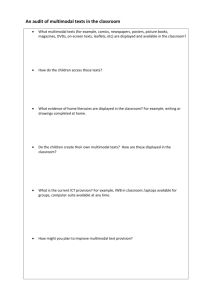

![Multimodal evidence of learning [DOC 45KB]](http://s3.studylib.net/store/data/007666677_2-5d54082e6a18fa7c91ee543af4725a90-300x300.png)
